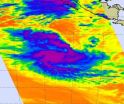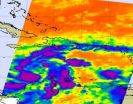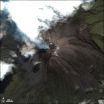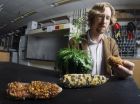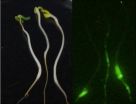(Press-News.org) At least six psyllid species have been found in the citrus-growing areas of the Rio Grande Valley of Texas, according to a U.S. Department of Agriculture (USDA) scientist who is working to control the spread of the psyllid-transmitted citrus greening disease.
A few years ago, citrus growers in south Texas noticed a new insect, the Asian citrus psyllid, on their citrus trees. This was a cause for concern, because this tiny pest is responsible for transmitting citrus greening, also known as Huanglongbing (HLB). The disease was first detected in Florida in 2005 and now poses a significant threat to the entire U.S. citrus industry.
Entomologist Donald Thomas with the Agricultural Research Service's (ARS) Kika de la Garza Subtropical Agricultural Research Center in Weslaco, Texas, has been monitoring psyllid populations in south Texas over the past year. ARS is the principal intramural scientific research agency of the USDA, and this research supports the USDA priority of promoting international food security.
With help from colleagues in Texas and Florida, Thomas has identified at least six psyllid species present in south Texas citrus groves. Some are native to the Rio Grande Valley, but others, like the Asian citrus psyllid, are not. The scientists are examining the life cycles of the six species to determine which of them can spread HLB. This will help scientists target certain species for control measures.
Thomas found that during the winter, psyllids live on torchwood, persimmon, mesquite and other trees that surround citrus groves. According to Thomas, the psyllids don't seem to be reproducing on these trees, but further testing to determine this is under way. Thomas also found abundant populations of psyllids in abandoned citrus groves and in urban areas where citrus trees are planted in backyards, indicating the need to develop management tools for use in these areas.
Thomas has presented his findings at the 2008 International Research Conference on Huanglongbing and the 2009 annual
meeting of the Entomological Society of America.
INFORMATION:
Read more about this research in the November/December 2010 issue of Agricultural Research magazine, available online at: http://www.ars.usda.gov/is/AR/archive/nov10/citrus1110.htm.
USDA is an equal opportunity provider, employer and lender. To file a complaint of discrimination, write: USDA, Director, Office of Civil Rights, 1400 Independence Ave., S.W., Washington, D.C. 20250-9410 or call (800) 795-3272 (voice), or (202) 720-6382 (TDD).
Psyllid identification key to area-wide control of citrus greening spread
2010-11-04
ELSE PRESS RELEASES FROM THIS DATE:
Main squeeze not needed for boa mom
2010-11-04
In a finding that upends decades of scientific theory on reptile reproduction, researchers at North Carolina State University have discovered that female boa constrictors can squeeze out babies without mating.
More strikingly, the finding shows that the babies produced from this asexual reproduction have attributes previously believed to be impossible.
Large litters of all-female babies produced by the "super mom" boa constrictor show absolutely no male influence – no genetic fingerprint that a male was involved in the reproductive process. All the female babies ...
UGA study finds moving animals not a panacea for habitat loss
2010-11-04
Athens, Ga. – New University of Georgia research suggests moving threatened animals to protected habitats may not always be an effective conservation technique if the breeding patterns of the species are influenced by a social hierarchy.
Research, published in the early online edition of the journal Biological Conservation, found an initial group of gopher tortoises released on St. Catherine's Island, Ga. were three times more likely to produce offspring than a later-introduced group, although the initial group had a much smaller proportion of reproduction-aged males.
"There ...
Most river flows across the US are altered by land and water management
2010-11-04
The amount of water flowing in streams and rivers has been significantly altered in nearly 90 percent of waters that were assessed in a new nationwide USGS study. Flow alterations are a primary contributor to degraded river ecosystems and loss of native species.
"This USGS assessment provides the most geographically extensive analysis to date of stream flow alteration," said Bill Werkheiser, USGS Associate Director for Water. "Findings show the pervasiveness of stream flow alteration resulting from land and water management, the significant impact of altered stream ...
The developmental dynamics of the maize leaf transcriptome
2010-11-04
Photosynthesis is arguably the most impressive feat of nature, where plants harvest light energy and convert it into the building blocks of life at fantastically high efficiency. Indeed modern civilization became possible only with the cultivation of plants for food, shelter and clothing.
While scientists have been able to discover details of the fascinating process by which plants store solar energy as chemical energy, how developing plants build and regulate their solar reactors is still poorly understood. How many genes are involved, and which are the most important? ...
Tropical Storm Anggrek is tightly wrapped in NASA satellite imagery
2010-11-04
Bands of strong thunderstorms are wrapping around the center of Tropical Storm Anggrek in the Southern Indian Ocean, according to satellite imagery. NASA's Aqua satellite captured an infrared look at those strong thunderstorms today.
NASA's Aqua satellite passed over Anggrek on Nov. 3 at 07:05 UTC (3:05 a.m. EDT) and the Atmospheric Infrared Sounder (AIRS) instrument onboard captured an infrared image of the cold thunderstorms within the system. The image showed that strong, high thunderstorm cloud tops tightly circled the storm's center. There was also strong convection ...
NASA satellite sees Tomas weaken to a tropical depression ... for now
2010-11-04
NASA infrared satellite data from this morning revealed that Tropical Storm Tomas has weakened into a tropical depression.
Tomas is in the central Caribbean Sea headed for Haiti this weekend, and forecasters are calling for a re-intensification before it makes landfall.
The National Hurricane Center (NHC) in Miami, Fla. reported at 5 a.m. EDT on Nov. 3 that hurricane hunter aircraft found an "ill-defined and elongated circulation with no tropical storm-force winds at the flight level or the surface." Thus, the status of Tomas was changed from a tropical storm to a ...
Volcanoes have shifted Asian rainfall
2010-11-04
Scientists have long known that large volcanic explosions can affect the weather by spewing particles that block solar energy and cool the air. Some suspect that extended "volcanic winters" from gigantic blowups helped kill off dinosaurs and Neanderthals. In the summer following Indonesia's 1815 Tambora eruption, frost wrecked crops as far off as New England, and the 1991 blowout of the Philippines' Mount Pinatubo lowered average global temperatures by 0.7 degrees F—enough to mask the effects of manmade greenhouse gases for a year or so.
Now, scientists have shown ...
Headgear, mouth guards have little or no impact on reducing concussions in rugby players
2010-11-04
TORONTO, Ont., Nov. 3, 2010 – Existing headgear and mouth guards have limited or no benefit in reducing concussions in rugby players, according to Dr. Michael Cusimano, a neurosurgeon at St. Michael's Hospital.
However, educational injury prevention programs that promote proper playing techniques and enforcement of the rules do result in a significant reduction in concussions and head, neck and spinal injuries, Cusimano concluded after a review of existing studies on the topic.
Cusimano still recommends rugby players wear mouth guards and protective headgear ...
Chromosome imbalances lead to predictable plant defects
2010-11-04
WEST LAFAYETTE, Ind. - Physical defects in plants can be predicted based on chromosome imbalances, a finding that may shed light on how the addition or deletion of genes and the organization of the genome affects organisms, according to a study involving a Purdue University researcher.
The findings identify easily measured characteristics that vary with imbalances of specific chromosomes, said Brian Dilkes, a Purdue assistant professor of horticulture. Understanding why and how those imbalances result in certain characteristics could open the door to correcting those ...
E. coli thrives near plant roots, can contaminate young produce crops
2010-11-04
WEST LAFAYETTE, Ind. - E. coli can live for weeks around the roots of produce plants and transfer to the edible portions, but the threat can be minimized if growers don't harvest too soon, a Purdue University study shows.
Purdue scientists added E. coli to soil through manure application and water treated with manure and showed that the bacteria can survive and are active in the rhizosphere, or the area around the plant roots, of lettuce and radishes. E. coli eventually gets onto the aboveground surfaces of the plants, where it can live for several weeks. Activity in ...


